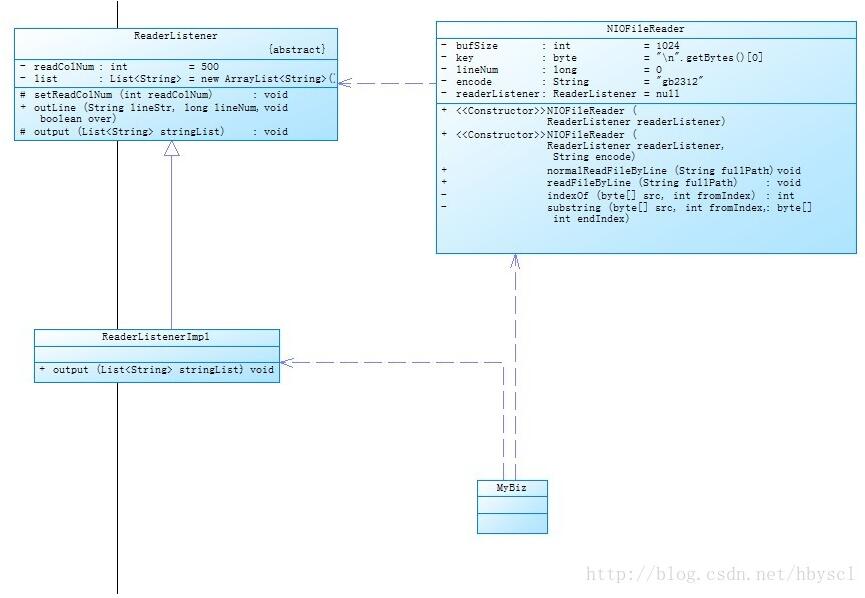java如何读取超大文件
作者:Okey
这篇文章主要为大家详细介绍了java如何读取超大文件,文中示例代码介绍的非常详细,具有一定的参考价值,感兴趣的小伙伴们可以参考一下
Java NIO读取大文件已经不是什么新鲜事了,但根据网上示例写出的代码来处理具体的业务总会出现一些奇怪的Bug。
针对这种情况,我总结了一些容易出现Bug的经验
1.编码格式
由于是使用NIO读文件通道的方式,拿到的内容都是byte[],在生成String对象时一定要设置与读取文件相同的编码,而不是项目编码。
2.换行符
一般在业务中,多数情况都是读取文本文件,在解析byte[]时发现有换行符时则认为该行已经结束。
在我们写Java程序时,大多数都认为\r\n为一个文本的一行结束,但这个换行符根据当前系统的不同,换行符也不相同,比如在Linux/Unix下换行符是\n,而在Windows下则是\r\n。如果将换行符定为\r\n,在读取由Linux系统生成的文本文件则会出现乱码。
3.读取正常,但中间偶尔会出现乱码
public static void main(String[] args) throws Exception {
int bufSize = 1024;
byte[] bs = new byte[bufSize];
ByteBuffer byteBuf = ByteBuffer.allocate(1024);
FileChannel channel = new RandomAccessFile("d:\\filename","r").getChannel();
while(channel.read(byteBuf) != -1) {
int size = byteBuf.position();
byteBuf.rewind();
byteBuf.get(bs);
// 把文件当字符串处理,直接打印做为一个例子。
System.out.print(new String(bs, 0, size));
byteBuf.clear();
}
}
这是网上大多数使用NIO来读取大文件的例子,但这有个问题。中文字符根据编码不同,会占用2到3个字节,而上面程序中每次都读取1024个字节,那这样就会出现一个问题,如果该文件中第1023,1024,1025三个字节是一个汉字,那么一次读1024个字节就会将这个汉字切分成两瓣,生成String对象时就会出现乱码。
解决思路是判断这读取的1024个字节,最后一位是不是\n,如果不是,那么将最后一个\n以后的byte[]缓存起来,加到下一次读取的byte[]头部。
以下为代码结构:

NioFileReader
package com.okey.util;
import java.io.*;
import java.nio.ByteBuffer;
import java.nio.channels.FileChannel;
/**
* Created with Okey
* User: Okey
* Date: 13-3-14
* Time: 上午11:29
* 读取文件工具
*/
public class NIOFileReader {
// 每次读取文件内容缓冲大小,默认为1024个字节
private int bufSize = 1024;
// 换行符
private byte key = "\n".getBytes()[0];
// 当前行数
private long lineNum = 0;
// 文件编码,默认为gb2312
private String encode = "gb2312";
// 具体业务逻辑监听器
private ReaderListener readerListener;
/**
* 设置回调方法
* @param readerListener
*/
public NIOFileReader(ReaderListener readerListener) {
this.readerListener = readerListener;
}
/**
* 设置回调方法,并指明文件编码
* @param readerListener
* @param encode
*/
public NIOFileReader(ReaderListener readerListener, String encode) {
this.encode = encode;
this.readerListener = readerListener;
}
/**
* 普通io方式读取文件
* @param fullPath
* @throws Exception
*/
public void normalReadFileByLine(String fullPath) throws Exception {
File fin = new File(fullPath);
if (fin.exists()) {
BufferedReader reader = new BufferedReader(new InputStreamReader(new FileInputStream(fin), encode));
String lineStr;
while ((lineStr = reader.readLine()) != null) {
lineNum++;
readerListener.outLine(lineStr.trim(), lineNum, false);
}
readerListener.outLine(null, lineNum, true);
reader.close();
}
}
/**
* 使用NIO逐行读取文件
*
* @param fullPath
* @throws java.io.FileNotFoundException
*/
public void readFileByLine(String fullPath) throws Exception {
File fin = new File(fullPath);
if (fin.exists()) {
FileChannel fcin = new RandomAccessFile(fin, "r").getChannel();
try {
ByteBuffer rBuffer = ByteBuffer.allocate(bufSize);
// 每次读取的内容
byte[] bs = new byte[bufSize];
// 缓存
byte[] tempBs = new byte[0];
String line = "";
while (fcin.read(rBuffer) != -1) {
int rSize = rBuffer.position();
rBuffer.rewind();
rBuffer.get(bs);
rBuffer.clear();
byte[] newStrByte = bs;
// 如果发现有上次未读完的缓存,则将它加到当前读取的内容前面
if (null != tempBs) {
int tL = tempBs.length;
newStrByte = new byte[rSize + tL];
System.arraycopy(tempBs, 0, newStrByte, 0, tL);
System.arraycopy(bs, 0, newStrByte, tL, rSize);
}
int fromIndex = 0;
int endIndex = 0;
// 每次读一行内容,以 key(默认为\n) 作为结束符
while ((endIndex = indexOf(newStrByte, fromIndex)) != -1) {
byte[] bLine = substring(newStrByte, fromIndex, endIndex);
line = new String(bLine, 0, bLine.length, encode);
lineNum++;
// 输出一行内容,处理方式由调用方提供
readerListener.outLine(line.trim(), lineNum, false);
fromIndex = endIndex + 1;
}
// 将未读取完成的内容放到缓存中
tempBs = substring(newStrByte, fromIndex, newStrByte.length);
}
// 将剩下的最后内容作为一行,输出,并指明这是最后一行
String lineStr = new String(tempBs, 0, tempBs.length, encode);
readerListener.outLine(lineStr.trim(), lineNum, true);
} catch (Exception e) {
e.printStackTrace();
} finally {
fcin.close();
}
} else {
throw new FileNotFoundException("没有找到文件:" + fullPath);
}
}
/**
* 查找一个byte[]从指定位置之后的一个换行符位置
* @param src
* @param fromIndex
* @return
* @throws Exception
*/
private int indexOf(byte[] src, int fromIndex) throws Exception {
for (int i = fromIndex; i < src.length; i++) {
if (src[i] == key) {
return i;
}
}
return -1;
}
/**
* 从指定开始位置读取一个byte[]直到指定结束位置为止生成一个全新的byte[]
* @param src
* @param fromIndex
* @param endIndex
* @return
* @throws Exception
*/
private byte[] substring(byte[] src, int fromIndex, int endIndex) throws Exception {
int size = endIndex - fromIndex;
byte[] ret = new byte[size];
System.arraycopy(src, fromIndex, ret, 0, size);
return ret;
}
}
ReaderListener
package com.okey.util;
import java.util.ArrayList;
import java.util.List;
/**
* Created with Okey
* User: Okey
* Date: 13-3-14
* Time: 下午3:19
* NIO逐行读数据回调方法
*/
public abstract class ReaderListener {
// 一次读取行数,默认为500
private int readColNum = 500;
private List<String> list = new ArrayList<String>();
/**
* 设置一次读取行数
* @param readColNum
*/
protected void setReadColNum(int readColNum) {
this.readColNum = readColNum;
}
/**
* 每读取到一行数据,添加到缓存中
* @param lineStr 读取到的数据
* @param lineNum 行号
* @param over 是否读取完成
* @throws Exception
*/
public void outLine(String lineStr, long lineNum, boolean over) throws Exception {
if(null != lineStr)
list.add(lineStr);
if (!over && (lineNum % readColNum == 0)) {
output(list);
list.clear();
} else if (over) {
output(list);
list.clear();
}
}
/**
* 批量输出
*
* @param stringList
* @throws Exception
*/
public abstract void output(List<String> stringList) throws Exception;
}
ReadTxt(具体业务逻辑)
package com.okey.util;
import java.io.File;
import java.util.HashMap;
import java.util.List;
import java.util.Map;
/**
* Created with IntelliJ IDEA.
* User: Okey
* Date: 14-3-6
* Time: 上午11:02
* To change this template use File | Settings | File Templates.
*/
public class ReadTxt {
public static void main(String[] args) throws Exception{
String filename = "E:/address_city.utf8.txt";
ReaderListener readerListener = new ReaderListener() {
@Override
public void output(List<String> stringList) throws Exception {
for (String s : stringList) {
System.out.println("s = " + s);
}
}
};
readerListener.setReadColNum(100000);
NIOFileReader nioFileReader = new NIOFileReader(readerListener,"utf-8");
nioFileReader.readFileByLine(filename);
}
}
以上就是本文的全部内容,希望对大家的学习有所帮助,也希望大家多多支持脚本之家。
